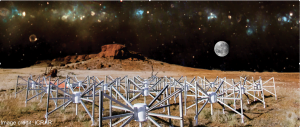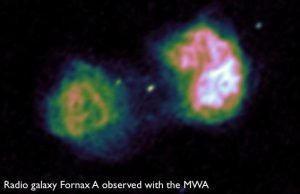The first billion years of the Universe’s evolution has yet to be observed in detail and very little is known about the first stars and galaxies that came into existence in this early period. One avenue to explore this epoch is to study the faint radio waves from neutral hydrogen atoms and there are now many experiments across the globe trying to do this. In 2018, the Experiment to Detect the Global Epoch of Reionization Signature (EDGES) detected a very unusual signal, which could be our first glimpse at the period when the first stars and galaxies began to heat the gas in the early Universe, a period known as Cosmic Dawn. There is now a great interest in the astronomical community to independently verify this detection, and that is currently the main focus of my research.
Neutral hydrogen atoms can randomly undergo an energy transition where their electron’s spin orientation ‘flips’, resulting in the emission of a photon with 21-cm wavelength. The early Universe was abundant with neutral hydrogen and, due to the expansion of the Universe, these early 21-cm photons have now been stretched (redshifted) to wavelengths between 1 – 6 m. We should therefore be able to observe a redshifted 21-cm signal from the early Universe using radio telescopes, however, there are complications. There are extremely bright foregrounds in the way that obscure the signal, including radio emission from our own Galaxy and from other extra-galactic sources, such as accreting supermassive black holes. Also, the instruments used to observe the radio emission can introduce small, but significant structure into an observed signal, due to imperfections in calibration. These two effects couple together, making the whole process of detection extremely difficult.
Bright foreground source Fornax A
The EDGES experiment used a single, well-calibrated, dipole antenna to observe the sky-averaged or ‘global’ sky signal at low radio frequencies corresponding to the redshift of Cosmic Dawn. My research is aimed at verifying this detection and extending the observation to higher frequencies in order to learn more about the period when the neutral hydrogen becomes ionised by radiating sources, the Epoch of Reionisation (EoR). To achieve this, I am using a novel approach that will have different systematic errors than EDGES and hence may provide a reliable, independent, verification. My research uses interferometers, rather than single antennas, in order to try and detect the global redshifted 21-cm signal. Interferometers (such as the Murchison Widefield Array (MWA) telescope in Western Australia) are not normally sensitive to this global signal, as they are designed to detect angular fluctuations of a signal across the sky. However, under some specific conditions, interferometers can be used in search of the elusive signal.
So far I have experimented with using the Moon as a known thermal reference source. It should be possible to determine the mean temperature of the sky occulted by the Moon using an interferometer (such as the MWA) if the spectrum and shape of the Moon is known. This project has encountered challenges such as dealing with reflected ‘earthshine’ from terrestrial radio transmitters, and also emission from the Galaxy bouncing of the Moon. Efforts are now concentrating on better understanding these sources of interference.

An MWA antenna tile (and the Moon!)
My current work is focussed on designing an experiment to use many, very short baselines of an interferometer. If the distance between two antennas in an interferometer is small enough, the baseline will be sensitive to a global signal as well as the angular variations. The main challenge of this experiment is to determine how the antennas affect each other in a process known as mutual coupling. If the mutual coupling effects introduce too much spectral structure into the observed signal then the redshifted 21-cm signature will be obscured or distorted. Simulations and early test observations using the Engineering Development Array-2, co-located with the MWA, are now underway. Experimentation with signal extraction techniques using simulated data is also underway.
ICRAR Statement
The content of this page is maintained by Benjamin McKinley, please contact them with any questions or comments on this content.
